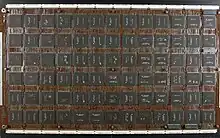向量处理器
向量处理器,又称数组处理器,是一种实现了直接操作一维数组(向量)指令集的中央处理器(CPU)。與之相比,标量处理器一次只能处理一个数据。向量处理器可以在特定工作环境中极大地提升性能,尤其是在数值模拟或者相似领域。向量处理器最早出现于1970年代早期,并在1970年代到1990年代期间主导了超级计算机的设计方向,尤其是多个克雷(Cray)平台。由于90年代末标量处理器设计性能提升,而價格快速下降,基于向量处理器的超级计算机逐渐让出了主导地位。

克雷YMP向量電腦的處理器板
现在,绝大多数商业化的CPU实现都能够提供某种形式的向量处理的指令,用来处理多个(向量化的)数据集,也就是所谓的SIMD(单一指令、多重数据)。常见的例子有 VIS, MMX, SSE, AltiVec 和 AVX。向量处理技术也能在游戏主机硬件和图形加速硬件上看到。在2000年,IBM、东芝和索尼合作开发了Cell处理器,集成了一个标量处理器和八个向量处理器,应用在索尼的PlayStation 3游戏机和其他一些产品中。
其他CPU设计还可能包括多重指令处理多重(向量化的)数据集的技术——也就是所谓的MIMD(多重指令、多重数据)——并实现了VLIW。此类设计通常用于特定应用场合,而不是面向通用计算机的市场化产品。在富士通的 FR-V VLIW/vector 处理器中,组合使用了两种技术。
基本特点
平行向量处理机最大的特点是系统中的CPU是专门定制的向量处理器(VP)。系统还提供共享存储器以及与VP相连的高速交叉开关。
来自现实世界的例子: x86 架构中的向量指令应用
// 改自英文維基 Vector_processor
//SSE simd function for vectorized multiplication of 2 arrays with single-precision floatingpoint numbers
//1st param pointer on source/destination array, 2nd param 2. source array, 3rd param number of floats per array
void mul_asm(float* out, float* in, unsigned int leng){
unsigned int count, rest;
//compute if array is big enough for vector operation
rest = (leng*4)%16;
count = (leng*4)-rest;
// vectorized part; 4 floats per loop iteration
if (count>0){
__asm __volatile__ (".intel_syntax noprefix\n\t"
"loop: \n\t"
"sub ecx,16 \n\t" // decrease address pointer by 4 floats
"movups xmm0,[ebx+ecx] \n\t" // loads 4 floats in first register (xmm0)
"movups xmm1,[eax+ecx] \n\t" // loads 4 floats in second register (xmm1)
"mulps xmm0,xmm1 \n\t" // multiplies both vector registers
"movups [eax+ecx],xmm0 \n\t" // write back the result to memory
"jnz loop \n\t"
".att_syntax prefix \n\t"
: : "a" (out), "b" (in), "c"(count), "d"(rest): "xmm0","xmm1");
}
// scalar part; 1 float per loop iteration
if (rest!=0)
{
__asm __volatile__ (".intel_syntax noprefix\n\t"
"add eax,ecx \n\t"
"add ebx,ecx \n\t"
"rest: \n\t"
"sub edx,4 \n\t"
"movss xmm0,[ebx+edx] \n\t" // load 1 float in first register (xmm0)
"movss xmm1,[eax+edx] \n\t" // load 1 float in second register (xmm1)
"mulss xmm0,xmm1 \n\t" // multiplies both scalar parts of registers
"movss [eax+edx],xmm0 \n\t" // write back the result\n\t"
"jnz rest \n\t"
".att_syntax prefix \n\t"
: : "a" (out), "b" (in), "c"(count), "d"(rest): "xmm0","xmm1");
}
return;
}
参阅
This article is issued from Wikipedia. The text is licensed under Creative Commons - Attribution - Sharealike. Additional terms may apply for the media files.